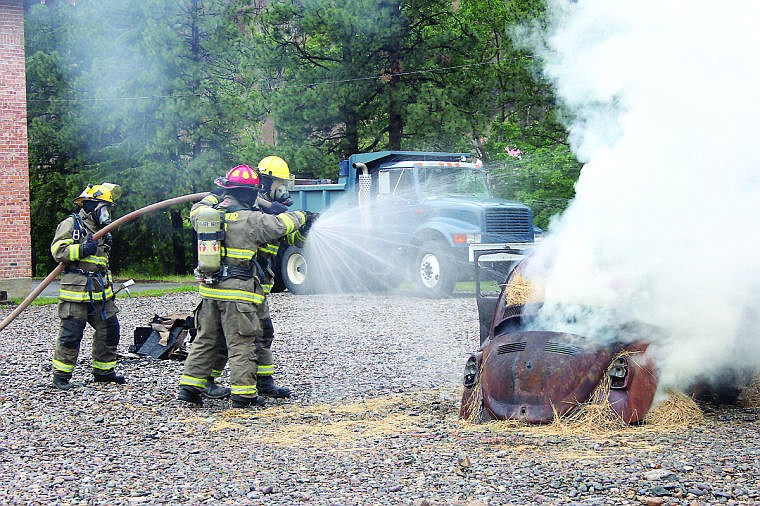Fire training heats up
SUPERIOR – The fire blazed fiercely propelling thick gray smoke into the air. Firefighters quickly got to work as they worked on a car fire.
“We do this maybe four times a year,” Superior Fire Chief John Woodland said.
The Superior Volunteer Fire Department trains two times a month, however, the group does not get to train on fire as often. During one of their monthly trainings, firefighters got to do just that.
At first the preparation began as any other training would. Those in attendance sat in the meeting room and went over the finer safety points of dealing with car fires.
When responding to a car fire, firefighters are encouraged to approach the car from an uphill direction, coming in at a 45-degree angle. This is the safest way for the responders to avoid a variety of hazards including exploding airbags, seatbelt retractors, bumpers and tires.
“We are pretty aggressive about training,” Woodland said.
Along with the monthly training sessions, Firefighter 1 classes are offered to newcomers. The class stretches 18 sessions and helps the volunteers learn the basics of firefighting.
Those who do complete the class are rewarded with a leather shield, which is placed on their helmets.
“That makes it really easy for an officer to look at someone coming up all geared up and also see their training level,” Woodland said.
After the basics were covered, the volunteers ran through a bunker drill, making sure all of their equipment was properly put on. The goal is to have no exposed skin, minimizing the risks of any burns while on call.
The firefighters were called out, pulling the fire truck out of the hall and back around to attack the car, which was already ablaze.
According to Woodland, training on real fire gives many an invaluable lesson. The hands-on experience gives newbies a chance to learn in a controlled situation, while providing the veterans in the field with reminders.
“I think the second evolution everybody did all their tasks better,” Rick Miller, assistant fire chief said. “You get back to the scene faster every time and you retain more.”
Miller was in charge of organizing the training and stopped halfway through the fire drill to discuss everyone’s progress.
He reminded everyone of the importance of sticking together.
“You go in as a group, you come out as a group. That’s a big deal for me,” Miller said. “For us the big thing to always remember is to stay together.”
The fire was extinguished in two bouts – the initial attack and then mop up efforts. In the second phase, firefighters tussled around the hay, which was stuffed into the old Volkswagen bug to ensure all of the hot spots were eliminated.
The firefighters will get yet another opportunity to practice on fire in the near future.
According to Woodland, the burn trailer should be arriving in Mineral County fairly soon, although a date has yet to be established.
The burn trailer travels from county to county and is provided by the Montana State Fire Service Training School. The metal box is set up as a house and provides the responders with an opportunity to attack a house fire.
With stairs, a window and even a metal sofa and bed set, the trailer allows participants to change different ventilation patterns in the building.
Wood shavings will be distributed in different areas within the trailer and the firefighters then attack the fire just as if it was a real house fire.
“For new firefighters who have never done it before we don’t do a lot of shavings. We don’t get it real hot,” Woodland explained. “For firefighters with quite a bit of experience, we’ll get it nice and hot before they go in.”
The trailer allows Woodland to customize the fire to the skill level of those involved. It also helps firefighters practice a few standard parts of firefighting such as the initial attack procedure.
“You first do a walk around of the structure before you consider going in. You look at exit points, ventilation points, power lines and gas tanks,” Woodland said.
The fire department currently has 24 volunteers, although some are more active than others.
On a typical training night 8-10 firefighters attend, while 12-14 responders typically respond to a call.

